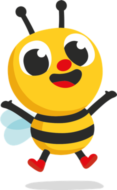Potion station
This is a great open-ended sensory activity that will engage your little one, supporting their imagination and vocabulary

Safety first
Always ensure that your child thoroughly washes their hands after taking part in garden activities and before eating. Be mindful of unsafe items your child might find such as berries.
What to do
Provide your child with a jug of water, old pots and pans and utensils such as whisks and wooden spoons. Explain to your child that we are going to make some potions! Encourage your child to think about what magic spell they could cast with their potion. Ask them to think of what ingredients they might need for their potion or suggest ideas such as a pebble, a feather, a crunchy leaf. Encourage your child to go and find the right ingredients. Introduce descriptive words such as fluffy, spiky or rough.
When you have added all of the ingredients to the pot invite your child to add some water. How much do they think they will need for their potion? Encourage your child to find a stick or spoon to stir their potion and say the spell "mix it slowly, mix it quick, mix it with your magic stick!"
More information
Children learn to understand and use new words by hearing them repeated often in familiar games and routines. Adults modelling new words, and responding to children's comments in a natural conversation way in a game really benefits their language development.
Magic paint
Support your child's early writing skills with this mark making experience for your garden

Safety first
Promote good hygiene practices by supporting your child to thoroughly wash their hands after spending time in the garden.
What to do
Collect together a paintbrush and a pot of water and go into your outdoor space. If you have any scents to hand such as vanilla extract, you may wish to add this to create your 'magic paint'.
Invite your child to dip their paintbrush into the 'magic paint' and then to create marks with their paintbrush on any surface in your garden.
Explore the marks together. Can we create large linear marks and circular marks on different surfaces? Can we create small movements and dots? Encourage your child to talk about their marks and model making your own.
More information
Supporting your child to create intentional marks including circular lines and dots is a progression in their early writing development.
Shadow dancing
Inspire your child's curiosity about shadows with this simple science experience.

Safety first
Ensure your child has a clear space in which to move before starting this experience.
What to do
Go outside and see if your child can discover their shadow on the ground. Perhaps objects in your garden are able to give you clues about good shadow spots.
Once you have found a casting position, create your first movement. See if your child is able to replicate this movement from looking just at your shadow.
Encourage your child to then create their first sequence of movements. Explain that you will watch their shadow and try and copy their movements. Encourage your child to test what their body can do. Can they balance on one leg? Wave their arms? Bend their knees?
Swap turns and see if you can create your own shadow dance movements. Following a few turns at this, see if your child can put together a sequence of movements and give their dance a name.
More information
Spatial awareness and balance are important so that children can move safely and avoid having accidents. Spatial awareness is also linked to later mathematics and problem solving.
UP for Educators
UP provides our educators with a wealth of quality learning experiences and essential guidance. UP pushes the boundaries to deliver even better learning outcomes, giving Busy Bees children the very best start in life. There is something on UP for all educators; download UP and see how this can enhance your practice today!








